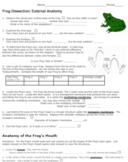
- #Student exploration frog dissection answer key skin#
- #Student exploration frog dissection answer key full#
Most importantly, you get a frog to dissect- an extra large grass frog, to be precise, whose larger size can really help when looking for smaller structures. You also get a very high-quality tool set including a broad-blade scalpel, plastic forceps, a variety of pins to help identify organs and structures and a set of sturdy scissors. It comes with a thorough and informative dissection guide that helpfully comes complete with full-color photos and informative labels. HomeScience Tools offers an excellent dissection kit for would-be amphibian anatomists. Similarly, as ancient amphibians, they have several unusual body structures (like their tongue) that can be explored to demonstrate how they’ve adapted and live within their ecosystems. When it comes to examining the organ systems of complex organisms, for example, a frog’s internal organs are laid out quite similarly to a human’s and can be a great introduction for students when exploring how their own bodies work. The frog dissection is a classic part of biology class, and for good reason.

Dissection Kits: Our Top Picks Frog Dissection Kit Our Pick: Homeschool Science Tools Frog Dissection Kit Generally speaking, specimens should come, at a minimum, in vacuum-sealed, triple-layered plastic bags (ideally one specimen per bag) to prevent leakage and decay. Regardless of what kit they purchase, parents should make sure that specimens are well preserved. Those looking to supplement their biology teaching with the occasional lab, or who are uncertain of how their students may feel about it, may be better served with a single specimen kit.
#Student exploration frog dissection answer key full#
These are generally better for homeschools that are following a full curriculum in biology with many labs involving a variety of lessons in vertebrate and invertebrate physiology.

There are kits that contain multiple specimens in one package. Those interested in a unit on the brain, on the other hand, would be better served by a sheep’s brain kit, which would provide ready access without having to do too much work. The type of specimen depends largely on the lesson plans involved.Ī full unit on mammalian systems, for example, may require exploring a fetal pig, which allows for a complete study of organs and systems in situ. The specimen is the heart of the dissection kit, being that which the lab lesson will revolve around. Stainless steel dissection tools are durable, easily cleaned with soap and water and won’t easily rust over time.Ī good quality dissection kit should come with a guide containing relevant and specific step-by-step instructions for the dissection exercise, as well as labelled photos or diagrams outlining and identifying key points of study for that specific specimen. In terms of quality, with the exception of the pipet, which is typically glass or plastic, and perhaps the forceps or tweezers, which can be made of plastic, most items in the dissection kit should be made of good quality stainless steel.
#Student exploration frog dissection answer key skin#
If the specimen is a brain, for example, you wouldn’t really need pins since there’s no skin to hold open. More specifically focused kits, such as those that examine only one organ, may only need more limited tools. That said, the exact tools you will need in a dissection kit depend heavily on the specimen involved. Generally speaking these each have their own particular use: Scalpelįor cutting through muscle, light bone and tissue, exposing/removing organsįor delicate separation and tissue manipulation In order to properly dissect and study a specimen, students will need proper tools.įor K-12 learning, at the very least these should include dissecting scissors, forceps/tweezers, a scalpel, and a curved or straight needle for pinning things down or open. In general, however, we believe a kit should contain the following items: What Should A Basic Dissection Kit Contain?ĭissection kits can vary a great deal based on factors such as price, the intended learning outcome, the specimen, the target age, and so on. It’s important not to force students to do something they don’t want to do for the sake of learning as there are alternatives to animal dissection kits (some we’ve included below) and there are a great many curricula out there that replace dissection with other activities. While dissection is a tradition in life science and biology study at the elementary, middle and high school level, and while it can offer tangible benefits to science learning, it is important to remember that not every student is comfortable or willing to do it.ĭissection does involve using real animal specimens and it is important to respect that and respect the fact that some students will have strong feelings about, or even moral objections to, dissection.

Before We Begin: A Note On Dissection and Learning


 0 kommentar(er)
0 kommentar(er)
